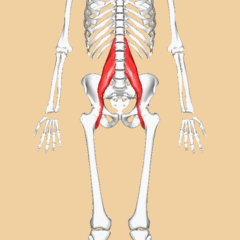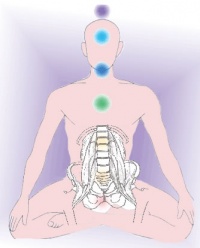Psoas Major: Difference between revisions
Samrah khan (talk | contribs) No edit summary |
No edit summary |
||
| Line 73: | Line 73: | ||
<references /> | <references /> | ||
[[Category:Anatomy]] | |||
Revision as of 23:25, 7 March 2018
Original Editor - User:Oyemi Sillo
Top Contributors - Vidya Acharya, Samrah khan, Lucinda hampton, Oyemi Sillo, Kim Jackson, George Prudden, Samson Chengetanai, Joao Costa, Maram Salem, Rachael Lowe and Kardelen Aktas;
Description
[edit | edit source]
Psoas Major is a long fusiform muscle placed on the side of the lumbar region of the vertebral column and brim of the lesser pelvis. [1]
Origin
[edit | edit source]
The psoas muscle is anatomically considered to have superficial and deep parts owing to the presence of branches of the lumbar plexus running through it.
Superficial part - overlies the lumbar plexus and takes origin from the sides of the T12 and L1 to L4 vertebrae including the intervening intervertebral discs.
The deep part which lies mainly deep to the branches of the lumbar plexus takes origin from the transverse processes of lumbar vertebrae L1 to L5.
Insertion[edit | edit source]
from this wide origin, the fibres of the muscle will converge as they descend on the posterior abdominal wall, cross the pelvic inlet/brim into the true, to form a long tendon. this tendon is joined within the pelvic region by musculotendinous fibres from the iliacus muscle to insert into the lesser trochanter of the femur.
Nerve Supply[edit | edit source]
Branches from the ventral rami of lumbar spinal nerves (L1, L2, and L3) before they join to form the lumbar plexus.
Blood Supply[edit | edit source]
The muscle receives blood from the four lumbar arteries from the aorta, from small branches of the renal arteries, from small muscular branches of the common iliac artery, and from the deep circumflex iliac artery.
Action
[edit | edit source]
- Flexion of the thigh at the hip
- Minimal action in lateral rotation and abduction of the thigh[2]
Function
[edit | edit source]
Stabilizes the lumbar spine [3], maintains erect posture when working in reverse action.
Clinical Importance of Psoas Muscle:
[edit | edit source]
Relatively the conditions that involves psoas muscles are less common. However, number of conditions that occurs involving iliac and psoas muscles, which includes infectious (particularly psoas abscess), haemorrhage, neoplastic lesions and injuries that takes place due to trauma and during surgical procedures.[4]
Psoas Syndrome and Iliopsoas Tendinitis:
[edit | edit source]
Psoas syndrome and iliopsoas tendinitis are less common musculoskeletal conditions therefore, they often go misdiagnosed, clinically it presents symptoms like low back pain, pain in groin and pelvis, radiating pain towards knee; which halts the primary function of psoas muscle that is hip flexion (hence difficult walking) and to sustain fully erect posture.The condition is mostly found in acute/overuse injuries, more commonly sports specific like runners, athletic activities, plyometric and among ballet dancers.[5][6][7] Prolong sitting and work which requires long sitting periods tend to put psoas in shortened and tight position that may leads to psoas syndrome.[8] Iliopsoas tendinitis may also cause snapping hip syndrome which is characterised by pain and snap (click) in groin.[9] Moreover, restriction of diaphragm can also occur due to psoas dysfunction and psoas spasm can potentially cause more disability of back muscles than other pathologic condition.[10]
Psoas, “the muscle of soul”.
The unique location of psoas makes it the deepest core muscle of human body and the only muscle that connects trunk to lower limb therefore, it plays a key role in stability and balance of human body.[11] In Yoga practices, psoas believed to be far more than just primary hip flexors. It affects your body from physical to psychological well-being. Liz Koch, author of “The Psoas Book” describes, “thepsoas is so intimately involved in such basic physical and emotional reactions, a chronically tightened psoas continually signals your body that you’re in danger, eventually exhausting the adrenal glands and depleting the immune system”.[12] So, psoas may seem like small muscle but its pivotal role in walking, postural alignment, balance, flexibility, joint mobility and organ functioning makes it clinically important to properly examine during assessment and screening.
Related links[edit | edit source]
References[edit | edit source]
- ↑ Gray, Henry. Anatomy of the Human Body. Philadelphia: Lea Febiger, 1918; Bartleby.com, 2000. www.bartleby.com/107/.
- ↑ http://www.wheelessonline.com/ortho/psoas
- ↑ Sandy Sajko, Kent Stuber. Psoas Major: a case report and review of its anatomy, biomechanics, and clinical implications. J Can Chiropr Assoc. 2009 Dec; 53(4): 311–318.
- ↑ Tonolini M, Campari A, Bianco R. Common and Unusual Diseases Involving the Iliopsoas Muscle Compartment: spectrum of cross-sectional imaging findings. Abdom Imaging. 2012; 37(1).
- ↑ Tufo A, Desai GJ, Cox WJ. Psoas syndrome: a frequently missed diagnosis. J Am Osteopath Assoc. 2012 Aug;112(8):522-8
- ↑ Psoas Syndrome. http://www.my.clevelandclinic.org/ (accessed 15 December 2016)
- ↑ Garry JP. Iliopsoas Tendinitis. http://www.emedicine.medscape.com/ (accessed 15 December 2016).
- ↑ O'Dwyer S. Iliopsoas Syndrome The Hidden Root of Pain. http://www.lower-back-pain-answers.com/ (accessed 15 December 2016)
- ↑ Iliopsoas Tendonitis and Snapping Hip. https://www.health.ucsd.edu (accessed 20 December 2016)
- ↑ Tufo A, Desai GJ, Cox WJ. Psoas syndrome: a frequently missed diagnosis. J Am Osteopath Assoc. 2012 Aug;112(8):522-8
- ↑ Wilbanks B. The ‘Muscle of the Soul’ may be Triggering Your Fear and Anxiety. http://www.wakingtimes.com/ (accessed 18 December 2016
- ↑ KOCH L. The Psoas is:. http://www.yogajournal.com/ (accessed 18 December 2016)








